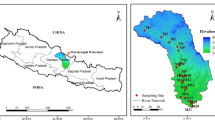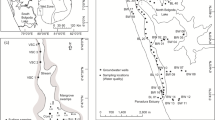Abstract
Investments in water resources infrastructure, especially hydropower dam, have been essential for economic development by generating electricity, but when they are improperly planned, designed, or operated, they can cause problems for downstream ecosystems and communities because of their impact on the volume, pattern, and quality of flow. This study aims to firstly assess the flow variations and secondly to characterize water quality variations resulting from dam construction and operation in the Sesan River. The findings from this study showed significant hydrologic alteration both during low flow and during high flow after the construction of Yali Falls Dam in Vietnam. Temporal change in maximum water level showed large differences before the dam construction of 6.8 m but accounting for only 5.2 m after dam operation. The fluctuation has been seen more severe after more several dams starting their operation. A significant reduction in flow duration in particular from 5 to 70% during the period 2001–2005 and more reduction in flow duration from 2009 to 2012 due to more water impoundments from new hydropower dam operation. The change in flow duration and flow characteristics could have more adverse impacts on the community livelihoods and ecosystem along the river system. Water quality dynamics have been also influenced by water release from the dam. The temporal variability of water quality in the Sesan River from June 2012 to May 2013 showed that TSS ranged from 1.5 to 333 mg/l, TP from 0.01 to 0.18 mg/l, NO3-N from 0.05 to 0.36 mg/l, and NH4-N from 0.03 to 0.26 mg/l. Our results can be used to enhance the understanding of the potential hydrologic changes due to the cascades of dam construction and rapid hydropower development in the Sesan River Basin. The study recommends for transboundary water resources management which includes disaster prevention and mitigation, dam operation rule, water quality, and environmental flow monitoring.





Similar content being viewed by others
References
Baird I, Mean M (2005) Sesan river fisheries monitoring in Ratanakiri province, northeast Cambodia: before and after the construction of the Yali Falls dam in the Central Highlands of Viet Nam
Batalla RJ, Gomez CM, Kondolf GM (2004) Reservoir-induced hydrological changes in the Ebro River basin (NE Spain). J Hydrol 290:117–136
Black KS, Tolhurst TJ, Paterson DM, Hagerthey SE (2002) Working with natural cohesive sediments. J Hydraul Eng 128(1):2–8
Bunn SE, Arthington AH (2002) Basic principles and ecological consequences of altered flow regimes for aquatic biodiversity. Environ Manag 30:492–507
Clesceri LS, Greenberg AE, Eaton AD (1998) Methylene blue active substances method # 5540 C
CNMC (2009) Profile Sub-area Sekong, Sesan Srepok in Cambodia, 99 p
Dang TH, Coynel A, Orange D, Blanc G, Etcheber H, Le LA (2010) Long-term monitoring (1960–2008) of the river-sediment transport in the Red River Watershed (Vietnam): temporal variability and dam-reservoir impact. Sci Total Environ 408(20):4654–4664
Dang TD, Cochrane T, Arias EA, Pham DT (2018) Future hydrological alterations in the Mekong Delta under the impact of water resources development, land subsidence and sea level rise. J Hydrl Reg Stud 15:119–133
EVN (2005) Electric of Vietnam: feasibility study report of the Sesan 4 hydropower project (Translation version for notification in MRC). Ministry of Industry, Hanoi
Francis JM, Nislow KH (2005) Changes in hydrologic regime by dams. Geomorphology 71:61–78
Friedl G, Wüest A (2002) Disrupting biogeochemical cycles—consequences of damming. Aquat Sci 64:55–65
Friedman JM, Osterkamp WR, Scott ML, Auble GT (1998) Downstream effects of dams on channel geomorphology and bottomland vegetation: regional patterns in the Great Plains. Wetlands 18:619–633
Fu KD, He DM, Lu XX (2008) Sedimentation in the Manwan reservoir in the Upper Mekong and its downstream impacts. Quatern Int 186(1):91–99
Grayson RB, Finlayson BL, Gippel CJ, Hart BT (1996) The potential of field turbidity measurements for the computation of total phosphorus and suspended solids loads. J Environ Manag 47(3):257–267
Hirji R, Davis R (2009) Environmental flows in water resources policies, plans, and projects: findings and recommendations. World Bank Publications, Washington
Kleeberg A, Hupfer M, Gust G (2008) Quantification of phosphorus entrainment in a lowland river by in situ and laboratory resuspension experiments. Aquat Sci 70(1):87–99
Kondolf GM (1997) PROFILE: hungry water: effects of dams and gravel mining on river channels. Environ Manag 21(4):533–551
Kondolf GM, Matthews WVG (1993) Management of coarse sediment in regulated rivers of California. University of California, Water Resources Center, Davis
Kummu M, Varis O (2007) Sediment-related impacts due to upstream reservoir trapping, the Lower Mekong River. Geomorphology 85(3–4):275–293
Lin Q (2011) Influence of dams on river ecosystem and its countermeasures. J Water Resour Prot 3(01):60
Lu X, Siew R (2006) Water discharge and sediment flux changes over the past decades in the Lower Mekong River: possible impacts of the Chinese dams. Hydrol Earth Syst Sci 10:181–195
Lu X, Li S, Kummu M, Padawangi R, Wang J (2014) Observed changes in the water flow at Chiang Saen in the lower Mekong: impacts of Chinese dams? Quatern Int 336:145–157
MRC (2003) State of the Basin Report: 2003, Mekong River Commission (MRC), Phnom Penh, 316 pp. ISSN:1728:3248
Petts GE (1984) Impounded rivers: perspectives for ecological management. Wiley, Hoboken
Richter B, Baumgartner J, Wigington R, Braun D (1997) How much water does a river need? Freshw Biol 37(1):231–249
Richter BD, Baumgartner JV, Braun DP, Powell J (1998) A spatial assessment of hydrologic alteration within a river network. Regul Rivers Res Manag Int J Devoted River Res Manag 14(4):329–340
Walling D, Fang D (2003) Recent trends in the suspended sediment loads of the world’s rivers. Glob Planet Change 39:111–126
Wyatt AB, Baird IG (2007) Transboundary impact assessment in the Sesan River Basin: the case of the Yali Falls Dam. Water Resour Dev 23:427–442
Xu J, Yan Y (2010) Effect of reservoir construction on suspended sediment load in a large river system: thresholds and complex response. Earth Surf Proc Land 35(14):1666–1673
Xue Z, Liu JP, Ge Q (2011) Changes in hydrology and sediment delivery of the Mekong River in the last 50 years: connection to damming, monsoon, and ENSO. Earth Surf Proc Land 36(3):296–308
Acknowledgements
The author would like to thank the Challenge Program on Water and Food (CPWF) for providing the grant. The research would not fruitfully be completed unless there is the financial support from AusAID.
Author information
Authors and Affiliations
Corresponding author
Additional information
Publisher's Note
Springer Nature remains neutral with regard to jurisdictional claims in published maps and institutional affiliations.
Rights and permissions
About this article
Cite this article
Chantha, O., Ty, S. Assessing changes in flow and water quality emerging from hydropower development and operation in the Sesan River Basin of the Lower Mekong Region. Sustain. Water Resour. Manag. 6, 27 (2020). https://doi.org/10.1007/s40899-020-00386-8
Received:
Accepted:
Published:
DOI: https://doi.org/10.1007/s40899-020-00386-8




